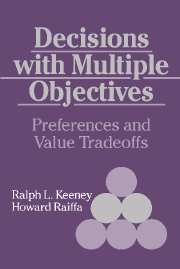Book contents
- Frontmatter
- Contents
- Preface to the Cambridge University Press Edition
- Preface to First Edition
- 1 THE PROBLEM
- 2 THE STRUCTURING OF OBJECTIVES
- 3 TRADEOFFS UNDER CERTAINTY
- 4 UNIDIMENSIONAL UTILITY THEORY
- 5 MULTIATTRIBUTE PREFERENCES UNDER UNCERTAINTY: THE TWO-ATTRIBUTE CASE
- 6 MULTIATTRIBUTE PREFERENCES UNDER UNCERTAINTY: MORE THAN TWO ATTRIBUTES
- 7 ILLUSTRATIVE APPLICATIONS
- 8 AIRPORT DEVELOPMENT FOR MEXICO CITY: A CASE STUDY
- 9 PREFERENCES OVER TIME
- 10 AGGREGATION OF INDIVIDUAL PREFERENCES
- Bibliography
- Index
1 - THE PROBLEM
Published online by Cambridge University Press: 05 July 2014
- Frontmatter
- Contents
- Preface to the Cambridge University Press Edition
- Preface to First Edition
- 1 THE PROBLEM
- 2 THE STRUCTURING OF OBJECTIVES
- 3 TRADEOFFS UNDER CERTAINTY
- 4 UNIDIMENSIONAL UTILITY THEORY
- 5 MULTIATTRIBUTE PREFERENCES UNDER UNCERTAINTY: THE TWO-ATTRIBUTE CASE
- 6 MULTIATTRIBUTE PREFERENCES UNDER UNCERTAINTY: MORE THAN TWO ATTRIBUTES
- 7 ILLUSTRATIVE APPLICATIONS
- 8 AIRPORT DEVELOPMENT FOR MEXICO CITY: A CASE STUDY
- 9 PREFERENCES OVER TIME
- 10 AGGREGATION OF INDIVIDUAL PREFERENCES
- Bibliography
- Index
Summary
In an uncertain world the responsible decision maker must balance judgments about uncertainties with his or her preferences for possible consequences or outcomes. It's not easy to do and, even though we all have a lot of practice, we are not very good at it. Here we suggest formal techniques that will be helpful in this decision-making process. We concentrate on formalizing the preference or value side of the problem rather than developing procedures for the assessments of uncertainties. This doesn't mean that we think modeling of the uncertainties is unimportant. However, we feel that many capable scholars have already dealt with the modeling aspects of the kind of problems we have in mind; our efforts on the value side of the problem are meant to complement theirs. So, let's assume that the assessments of uncertainties are given, and let's worry about how we, as decision makers, can make sense out of our conflicting values, objectives, or goals and arrive at a wise decision. As one of our associates expressed it, “the aim of the analysis is to get your head straightened out!”
We suggest—or prescribe—how a decision maker (perhaps you) should think systematically about identifying and structuring objectives, about making vexing value tradeoffs, and about balancing various risks. The following sketches of problems will set the stage.
- Type
- Chapter
- Information
- Decisions with Multiple ObjectivesPreferences and Value Trade-Offs, pp. 1 - 30Publisher: Cambridge University PressPrint publication year: 1993
- 2
- Cited by

